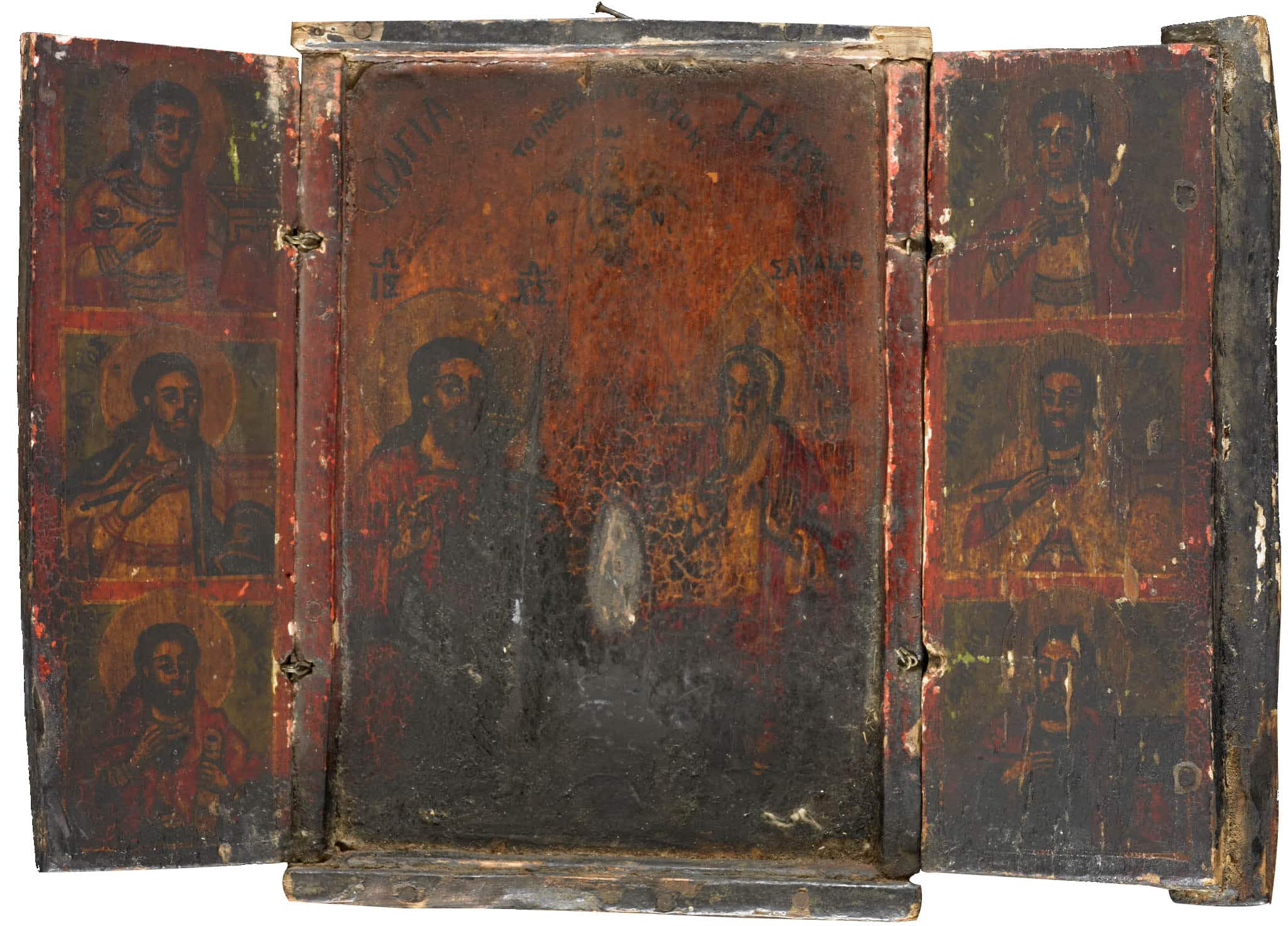The triptych is painted in egg tempera on wood primed with gesso over fabric. The central panel depicts Christ at the left, blessing with his right hand and holding a book in his left. He has a cross nimbus, and the inscription O ω N (‘He Who Is’). To the right God is shown with long white hair and beard. He is shown blessing. He has a triangular halo. Above is the dove of the Holy Spirit. The Holy Trinity is therefore the central theme of this small triptych, while three saints in bust-length format are portrayed on each of the side wings. Black painted inscriptions in majuscule Greek identify the figures. The main composition is inscribed Η ΑΓΙΑ ΤΡΙΑC (‘The Holy Trinity’), CΑΒΑωΘ (‘Sabaoth’), Ι(ΗCΟΥ)C Χ(ΡΙCΤΟ)C (Jesus Christ), ΤΟ ΠΝΕΥΜΑ ΤΟ ΑΓΙΟΝ (‘The Holy Spirit’), Ο ω Ν (‘He Who Is’). On the left wing, reading from top to bottom are: Ο ΑΓΙΟC ΠΑΝΤΕΛΕΗΜωΝ (St Pantolemon), Ο ΑΓΙΟC ΚΟCΜΑC (St Cosmas) and Ο ΑΓΙΟC ΘΑΛΑΛΑΙΟC (St Thalalaios). Following the same order, on the right wing are: Ο ΑΓΙΟC ΠΡΟΚΟΠΙΟC (St Prokopios), Ο ΑΓΙΟC ΔΑΜΙΑΝΟC (St Damianos) and Ο ΑΓΙΟC ΑΠ ΛΟΥΚΑC (The Holy Ap[ostle] Luke). On the exterior of the wings, when closed, one can discern the shape of the cross and the formula IC XC NIKA (‘Jesus Christ Conquers’) painted in red. The triptych is covered with priming, is very dirty, and has suffered fire damage and blistering; it is, therefore, very dark, particularly on the lower part of the central panel.
In the central panel, Christ is shown as an adult, seated on the right hand of the Father, who is represented as the Ancient of Days with white hair and beard and a halo in the shape of an equilateral triangle, emphasising the Trinity. The Holy Spirit in the form of a dove is hovering above them with open wings. In Byzantium, the Holy Trinity was generally depicted symbolically as the Hospitality of Abraham (Genesis 18: 1–15). However, images of the anthropomorphic Trinity started appearing from as early as the 12th century as seen in the Gospel book Vienna MS. Suppl. Gr, fol. 1v. and the fresco decoration of Panagia Koumbelidiki or Kastriotissa, Kastoria, dated to c. 1260–80 (Papadopoulos 1968; Pelekanidis and Chatzidakis 1985). In both works Christ is represented as an adult, sitting in the lap of the larger figure of the Ancient of Days, and holding the Holy Spirit in the form of a dove. The depiction of the Trinity in the iconographic type of the BM panel with God the Father and Christ sitting next to each other and the Holy Spirit hovering above them appears in the 14th century and is frequently encountered in icons produced after the Fall of Constantinople in 1453 (Xyngopoulos 1936). The earlier type is often referred to as the Old Testament Trinity and the later scheme as the New Testament Trinity.
The saints of the side panels are portrayed frontally in bust form. Those on the left wing are healer saints, as is St Damian, painted in the middle of the right panel, in correspondence to the image of his brother, St Cosmas, placed between St Pantoleon and St Thalalaios. All four have similar poses, holding a medicinal container with their left hand and a spoon for dispensing medicines with their right. St Prokopios is a military saint although in this case he is not depicted in armour, holding a spear, as he usually is, but is represented as a martyr, holding a cross with his right hand and raising the other open outwards. He is holding the cross horizontally rather than upright, similar to the way the healer saints hold their spoons. St Luke’s pose is analogous: he is holding, presumably, a pen and a codex, though it is difficult to tell with certainty as his image is very dark on account of the fire damage.
Despite the triptych’s poor state of preservation, one can still discern its stylistic features, which represent 19th-century folk painting of the Balkans. The figures are rendered in dark bold outlines, the garments appear rather flat and the faces are given coarse characteristics. The small size and shape of the panel suggest that it was used for private worship. The existence of four healer saints is also in line with this function, while the portrayal of a military saint may be an indication that the owner was serving in the army. This would be in keeping with the information that the panel was found on a battlefield.
Literature: X.A. Xyngopoulos, Μουσείον Μπενάκη. Κατάλογος των Εικόνων, Athens, 1936, 16–17; S.A. Papadopoulos, ‘Essai d’interprétation du thème iconographique de la paternité dans l’art Byzantin’, Cahiers Archéologiques 18 (1968), 121–36, at 133–5, figs 9–10; S. Pelekanidis and M. Chatzidakis, Kastoria, Athens, 1985, 85–7, 90, fig. 7;
- Cormack, Icons, London, 2007 (repr. 2014), 136, no. 95.
Eleni Dimitriadou
